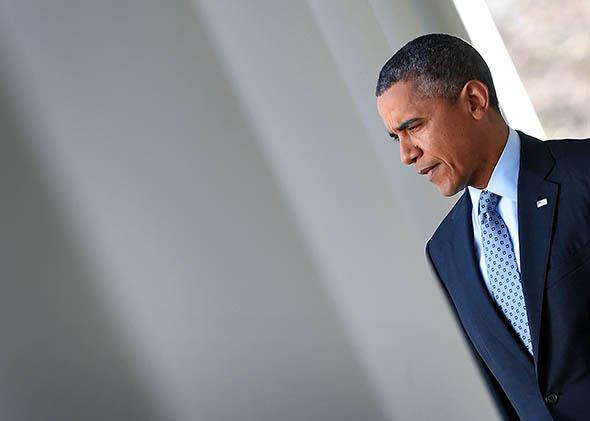On Tuesday, President Obama celebrated the success of two franchises known for their long-suffering fans: He hosted the World Series champion Boston Red Sox and announced that his health care plan had signed up 7.1 million people. That number exceeded the hopes of administration officials before Oct. 1 of last year when the six-month sign-up period began. Given the protracted calamity of the launch of the health care website, besting the 7 million target was a near miracle. “Armageddon has not arrived,” said the president, tweaking the Republicans who have fought him at every inch as he has tried to implement the law.
The final assessment of the Affordable Care Act is a long way off, but one preliminary conclusion can be drawn from this milestone: “No Drama” Obama learned the focusing power of panic. A president who came to office promising an end to the private drama of the Clinton era and the global drama of the Bush era and whose greatest personal attribute may be his placid temperament was in the Rose Garden on Tuesday celebrating the clarifying benefit of a big collective freakout.
Before the failed launch of the Affordable Care Act, senior administration officials regularly attested to the president’s focus on the implementation of the law. He asked about the Oct. 1 launch every day. When administration officials were forced to address what they saw as silly distracting issues—from questions about the response to the Benghazi, Libya, attack to the Internal Revenue Service scrutiny of conservative groups—they said they were focused on bigger, more important things. Chief of staff Denis McDonough told his staff to focus 90 percent of their energy on important things and only 10 percent on the daily obsessions of their opponents and the news media. A big portion of that 90 percent was presumably making sure that the health care launch would go well.
Then it didn’t go very well at all. Despite the stakes, the supposed focus, and three years to plan, the administration was not equipped to carry out its mission. It was only after everything fell apart and Democrats up for re-election started screaming that the administration went to its panic stations. The president moved aside the architects of the sabotage who had been running the show and installed management consultant Jeffrey Zients. He also brought back political veterans to man the rescue effort, which identified problems and tackled them in a systematic way. Under less fraught circumstances, administration officials might have worried more about the possible political fallout of repeatedly moving deadlines and modifying the law on the fly, but in crisis mode, the choice became easier. The repair effort did not take on all the hallmarks of panic. None of the key players were ever held accountable by firing, but the pace quickened, and the performance improved considerably.
There is a management question at the heart of this management failure. Could the 7 million figure have been reached without the panic? If the site had been working from the first day, perhaps the sign-ups would have netted 7 million. But without the illuminating mood of panic—which focused the mind and allowed for bringing in talented people who had a mandate to cut through the bureaucratic fog—would it have been possible to create a website that worked? Would the president have been so easy to persuade that he should appear on Between Two Ferns? Would it have been so easy to mobilize the entire operation for the push that included more than 300 radio appearances by the president and others in the administration, 5,000 events on the ground, and 33 million views on the specialized online content they produced? The battle-stations effort Politico reports on was not there before the calamity, and there’s no evidence that the president and his team could generate that kind of action on their own.
Unlike the Red Sox, the administration hasn’t won the title; it’s simply come from behind in Game 1 of a multigame series. We won’t know how the health care law is working until we learn how many people have paid, how healthy they are, and where they live in the country. Then we’ll see how the insurance companies calculate their premiums, whether doctors and nurses are available to treat all the new patients, and how big the reduction is in the number of uninsured.
If all of those figures ratify the sense of satisfaction at the White House, there will still be a big management question up for grabs. Was the colossal management failure of the Obamacare launch the predictable result of trying to get the government to do something so big in a time of near absolute partisanship, a special screw-up of the Obama team, or some combination of the two? The president said Tuesday that the rollout was simply what “change looked like.” (All births are messy!) But if that’s so, and this is just the normal way of things, then that tells us something about the Obama management model or perhaps White House management more broadly. The only way to do big things is either to create an existential panic or to have a chief executive who can instill a little drama on the front end before the focusing fire drill begins.
